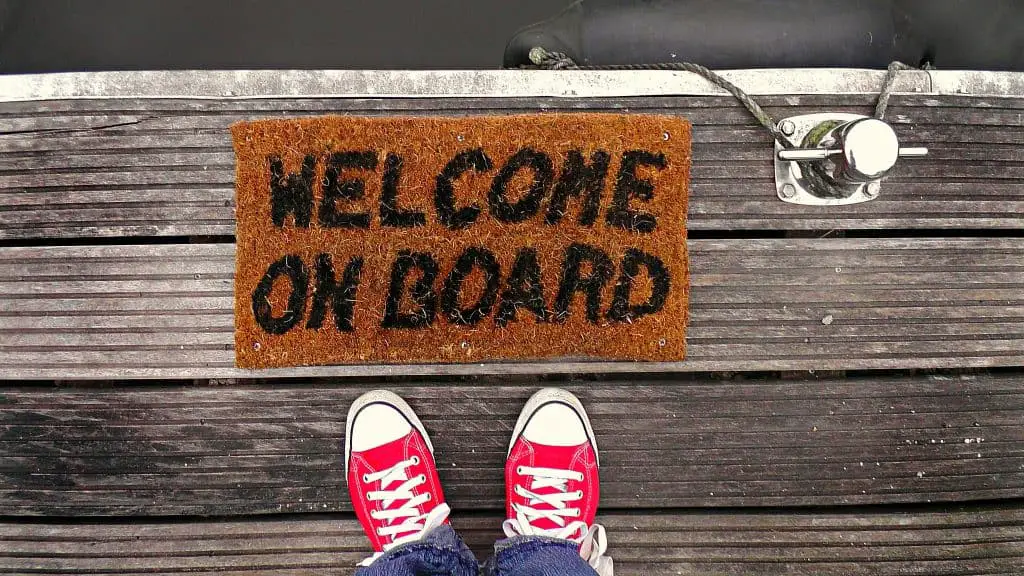Practice English or Spanish with AI here
Welcome on board and welcome aboard have the same meaning. Welcome aboard is more common to use when someone joins a team. It is a friendly way to let someone know that they are welcome to become part of the team.
Differences between Aboard and On Board
Welcome Aboard: This idiom is frequently used as a friendly greeting when welcoming someone onto a mode of transport, such as a plane, train, or ship. It can also be employed when welcoming a new member to a team, organization, or social club. As an adverb, “aboard” means “on or into a ship, aircraft, or other vehicles.” When using “aboard” as a preposition, it communicates the same idea—for example, “She climbed aboard the train.”
Welcome On Board: Similar to “welcome aboard,” “welcome on board” is also used to welcome individuals onto various modes of transport. Additionally, it is commonly used in professional settings when introducing new employees or team members. In this context, “on board” functions as a verb phrase, indicating the action of joining a team or organization. As a side note, the term “on board” does not require a hyphen.
While both phrases can serve as synonyms and are often used interchangeably, “welcome aboard” is more popular in informal and recreational settings, whereas “welcome on board” is more commonly found in professional and workplace contexts.
To recap, here are the key takeaways regarding each phrase:
- Welcome Aboard:
- Idiom used in informal and recreational settings
- Functions as an adverb or preposition
- Does not require a hyphen
- Welcome On Board:
- Verb phrase often used in professional and workplace contexts
- No hyphen required
Understanding the nuances of “welcome aboard” and “welcome on board” will enable you to make informed choices when using these expressions. Keep in mind the context in which you’re using the phrase and select the one that best fits your situation.
Contextual Use
Welcome Aboard as a Greeting
In a formal business context, both “welcome aboard” and “welcome on board” are used to convey the same sentiment. This greeting is often seen in written communication when welcoming a new employee to a team or organization, expressing the incorporation of the individual into the team. In this instance, “welcome aboard” functions as a friendly yet professional introduction.
Welcome Onboard in Transportation
In the transportation industry, the phrase “welcome onboard” is commonly employed. This term is regularly used to welcome travelers aboard vessels such as boats, airplanes, and trains. While both “welcome onboard” and “welcome aboard” are suitable, using “onboard” can give a more formal tone, which makes it appropriate for various transportation settings.
Casual Usage of Welcome Aboard
In informal situations, “welcome aboard” can be used more casually to greet new members of a group or simply to express excitement when someone joins a shared activity. Here, the phrase can imply a sense of camaraderie, making it fitting for casual usage. Its comfortable and inviting tone can also lend itself well to informal written communication, such as invitations or social media posts.
In the Corporate World
The Onboarding Process
When you join a new company or team, there’s often an onboarding process. This involves HR and your colleagues helping you settle into your new role. They’ll provide you with the necessary training and resources to ensure you’re well-equipped to take on your new job responsibilities. During this time, it’s common for organizations to use phrases like “welcome on board” or “welcome aboard” to make new employees feel more at ease and part of the team.
Sending a Welcome Aboard Email
A welcome aboard email is typically sent by a team member or HR representative to a new employee. It aims to make the new member feel valued, provide relevant information about the company culture and mission, and offer assistance in their transition to the workplace. In this email, you might convey the message using “welcome on board” or “welcome aboard” to signify their entry into the organization.
For example:
Subject: Welcome Aboard, [New Employee's Name]
Dear [New Employee's Name],
We are excited to have you join our team and look forward to working with you. Your background and expertise will be valuable assets to our organization.
Here at [Company Name], we strive for excellence and believe in fostering a positive and collaborative workplace culture.
Please don't hesitate to reach out to your colleagues or HR for any assistance you may need during your onboarding process.
Once again, welcome aboard!
Best regards,
[Your Name]
Participating in Workplace Culture
Thriving in your new workplace often requires more than just mastering job skills. It’s also crucial to be an active participant in the organization’s culture. As you become more involved with company events, team-building activities, and everyday interactions with colleagues, the phrases “welcome on board” and “welcome aboard” will often be used, emphasizing your inclusion and participation in the workplace situation. Here are some examples:
- When invited to a team lunch, a colleague may say, “Welcome aboard! I hope you enjoy the food and company.”
- Your manager may say, “Welcome on board” during team meetings when assigning a new project or task.
- Attending social events or volunteering for company charity activities can lead to remarks like “Thank you for joining in, and once again, welcome on board!”
Remember, effectively participating in your new organization’s culture will positively impact your overall experience, so embrace the journey, and enjoy being welcomed aboard.
In the World of Transport
All Aboard: The Conductor’s Call
When you board a train, you might hear the conductor’s friendly call, “All aboard!” This phrase signals that it is time to get on the train and find your seat. As a passenger, you’ll appreciate the welcoming tone of the conductor and the clear instruction to board the train quickly and efficiently.
Aboard the Ship: The Captain’s Welcome
As you step onto a ship, whether it’s a cruise liner or a smaller boat, you may hear the captain or crew members saying, “Welcome aboard!” This greeting is used to make passengers feel comfortable and welcomed on the vessel. It helps to create a positive atmosphere right from the start of your journey. Boats and ships offer a unique travel experience, and this friendly greeting aims to enhance your overall enjoyment.
Flight Attendant’s Welcome Aboard
When entering an airplane, the flight attendants will often greet you with a warm “Welcome aboard!” This greeting signifies the airline’s recognition of you as a valued passenger and is meant to make you feel appreciated. As you settle into your seat, you’ll find that your journey through the world of air transportation is met with a friendly and professional demeanor from airline staff, ensuring you have a pleasant flight experience.
Significance and Impact
When you welcome someone using the phrases “welcome aboard” or “welcome on board,” you are not only greeting them but also making them feel like a part of the group. These expressions hold considerable significance in making new members feel comfortable and creating a positive environment. Both phrases can be attributed to welcoming someone onto a mode of transport, such as a boat, train, or plane. In modern contexts, this extends to welcoming people into teams, workplaces, and organizations.
Your choice of words when greeting someone can have an impact on how they perceive the group environment. By using a friendly and inclusive tone like “welcome aboard” or “welcome on board,” new members are likely to feel a sense of belonging and motivation for moving forward with the team. This positive initiation can strengthen teamwork and foster a collaborative atmosphere.
Moreover, these phrases suggest that the group or organization is viewed as a collective entity, working together towards common goals. By welcoming someone aboard, you are expressing that you value their contribution, and you have confidence in their ability to play their part in the team’s progress. This recognition can elicit a positive response and may encourage stronger commitment from the individual.
In some cases, expressing gratitude by saying “thank you” will show appreciation for the individual’s involvement, further strengthening the bond between them and the group. Remember, the idea behind using these welcoming phrases is to create a favorable impression, fostering a sense of unity that contributes to the overall success of the team.
Keep this in mind when choosing between “welcome aboard” or “welcome on board” in professional or personal contexts. Both phrases convey inclusion, appreciation, and encouragement, ensuring that new members feel valued and eager to contribute to the group’s objectives.
Conclusion
In wrapping up, both “welcome aboard” and “welcome on board” share similar meanings and can be used interchangeably in most situations. These phrases often apply to welcoming passengers onto vessels or expressing a warm greeting to newcomers in teams or social organizations.
As you move forward, remember that adopting a friendly and clear tone is key when using these phrases. It helps in fostering a sense of inclusion and eases the integration of new members into your team or community.
To maintain a confident and knowledgeable demeanor, always be aware of the context when choosing between “welcome aboard” and “welcome on board.” Although subtle, the variations in usage can contribute to effective communication and ensure the intended message is delivered.
Ultimately, selecting the appropriate term will not only showcase your language proficiency but also create a pleasant environment for those you are welcoming.
Frequently Asked Questions
What is the difference between welcome aboard and welcome on board?
Both “welcome aboard” and “welcome on board” can be used interchangeably, as they are both grammatically correct. While “welcome on board” is more commonly used in workplace situations and formal writing, “welcome aboard” is often used as a reference to boarding an airplane or a boat.
How to use welcome aboard in a sentence?
Here are some examples of using “welcome aboard” in a sentence:
- Welcome aboard, Jane! It’s great to have you join the team.
- Please fasten your seatbelts and welcome aboard flight 101.
- Welcome aboard the cruise! We hope you enjoy your journey with us.
What are some synonyms for welcome aboard?
Some synonyms for “welcome aboard” include:
- Welcome to the team
- Warmest welcome
- Pleased to have you
- Delighted to meet you
How to write a welcome on board email?
When writing a welcome on board email, be sure to:
- Begin by greeting the new member.
- Introduce yourself and your role in the team.
- Introduce the new member to the rest of the team and provide some background information.
- Offer assistance and resources that the new member might need to settle in.
- Provide information about the organization, company culture, or practices.
- End the email by expressing your enthusiasm for working with the new member.
How to pronounce welcome aboard correctly?
Here is a simple guide to the pronunciation of “welcome aboard”:
- Welcome: /ˈwɛl_kəm/
- Aboard: /əˈbɔrd/
For a clear pronunciation, say “Welcome aboard” as “well-kum a-board.”
What are some professional ways to say welcome on board or welcome aboard?
Professional alternatives to “welcome on board” or “welcome aboard” include:
- We are delighted to have you join our team.
- Warmest greetings and congratulations on becoming part of our organization.
- Your expertise and skills are a valuable addition to our team.
- We look forward to a successful collaboration and a productive working relationship.
Is it welcome on board or welcome aboard for a new employee?
You can say either really, It doesn’t matter.
For me, I would use welcome on board if I needed to be formal (in an email for example).
If I wanted to be friendly and welcoming, I would use welcome aboard.
What is the meaning of “On Boarding a new employee”
On boarding a new employee is the process that a new employee goes through to become familiar with the new company.
That could include setting up a company email address, learning where everything is, and becoming familiar with the software that a company uses.
How to reply to a welcome on board email?
There are many ways to respond to a welcome on board email depending on the impression you want to give to your new boss or colleagues. You can read some suggested replies here.
- 10 Words or Phrases “To Make Her Feel Special” - October 16, 2024
- Synonym Generator - September 11, 2024
- [BrutallyHonest] Langua AI Review – Can you learn a language with AI? - April 23, 2024


